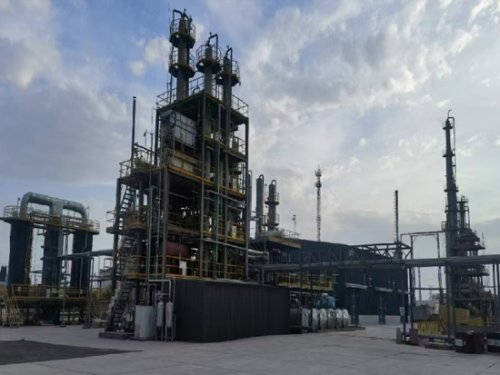
Non-hydrogen dewaxing equipment plays a vital role in the petrochemical industry, especially in maintaining the flowability of petroleum products in low-temperature environments. By employing non-hydrogen dewaxing technology, companies can optimize product flowability and cold flow performance, thereby enhancing production efficiency and product quality. This article delves into the working principles of non-hydrogen dewaxing equipment and explores its advantages and challenges in practical applications.

I. Working Principles of Non-Hydrogen Dewaxing Equipment
Non-hydrogen dewaxing technology mainly aims to lower the freezing point of petroleum products to improve their low-temperature flowability. The core of this process involves altering the molecular structure of petroleum products through physical or chemical methods to maintain good flowability under low-temperature conditions. Here are the basic principles of non-hydrogen dewaxing equipment:
1.Temperature Control and Adjustment
Non-hydrogen dewaxing equipment is equipped with precise temperature control systems. By adjusting the temperature in the reactor, the equipment effectively manages the dewaxing process. The temperature is usually maintained below the freezing point of the petroleum product but above the conventional processing temperature to ensure effective dewaxing.
2.Additive Application
Non-hydrogen dewaxing processes often use dewaxing agents or other chemical additives to lower the freezing point of petroleum products. These additives interact with waxy or other solidifying components in the petroleum, altering their crystal structure to reduce the freezing point. The equipment includes an automatic additive dosing system to ensure accurate and even distribution of additives.
3.Mixing and Reaction
The mixing system within the equipment ensures that petroleum products and dewaxing agents are uniformly mixed, facilitating effective reaction. Efficient mixing and reaction are crucial for achieving the desired dewaxing effect. The equipment typically features high-efficiency stirring devices and reactors to promote uniform reactions.
4.Cooling and Separation
During the dewaxing process, the equipment may require a cooling system to manage reaction temperatures and enhance the action of dewaxing agents. Additionally, post-reaction, the equipment needs separation devices to separate the dewaxed petroleum product from unreacted additives.
5.Monitoring and Control
Non-hydrogen dewaxing equipment is equipped with advanced monitoring and control systems. By continuously monitoring reaction temperature, pressure, and additive concentration, the equipment can automatically adjust parameters to ensure stable and efficient dewaxing.
II. Applications of Non-Hydrogen Dewaxing Equipment
1.Petroleum Industry
In the petroleum industry, non-hydrogen dewaxing equipment is primarily used to enhance the low-temperature flowability of crude oil and finished products, particularly for transportation and storage in cold regions. By lowering the freezing point, the equipment ensures smooth flow of petroleum products in low-temperature environments, reducing issues during transportation and operations.
Optimize Low-Temperature Flowability: Ensure petroleum products remain flowable in low-temperature conditions.
Improve Transportation Efficiency: Reduce the risk of solidification in cold environments to ensure smooth transportation.
Reduce Energy Consumption: Lower heating requirements, reducing energy consumption and operational costs.
2.Chemical Industry
In the chemical industry, non-hydrogen dewaxing equipment processes chemicals with high molecular weight components that tend to solidify at low temperatures. Dewaxing treatment optimizes the flowability and processing performance of these chemicals, enhancing production efficiency and product quality.
Improve Chemical Flowability: Ensure high-molecular-weight chemicals remain flowable in low-temperature conditions.
Enhance Production Efficiency: Reduce solidification issues to improve production line stability and efficiency.
Improve Product Quality: Enhance flowability to improve the quality and consistency of the final product.
3.Natural Gas Processing
In natural gas processing, non-hydrogen dewaxing equipment handles condensates that can cause blockages and operational difficulties at low temperatures. Effective dewaxing treatment improves the flowability and processing efficiency of natural gas.
Reduce Condensate Accumulation: Prevent low-temperature condensate blockages in equipment.
Optimize Processing Flow: Enhance stability and efficiency of the natural gas processing flow.
Ensure Safe Operation: Minimize operational risks and safety hazards associated with condensate buildup.
III. Key Considerations When Selecting Non-Hydrogen Dewaxing Equipment
1.Processing Capacity
The equipment’s processing capacity must match the actual production scale. Choose the appropriate model and specifications to meet production needs, avoiding over-investment or insufficient equipment issues.
2.Dewaxing Effectiveness
Evaluate the equipment’s dewaxing effectiveness, including the extent of freezing point reduction and stability of the effect. Select equipment that provides high-quality dewaxing to meet production requirements.
3.Energy Efficiency and Costs
Opt for energy-efficient equipment to lower operational costs. Assess the equipment’s energy consumption, maintenance costs, and return on investment to maximize economic benefits.
4.Equipment Stability and Maintenance
The stability and maintainability of equipment directly affect production efficiency and long-term operating costs. Choose equipment with a well-designed structure and durability to reduce failure rates and ensure stable long-term operation.
5.Supplier Reputation and Service
Choose equipment from reputable suppliers to ensure quality and obtain excellent after-sales service. Understand the supplier’s market reputation and customer reviews to guarantee long-term stable operation and support.
IV. Conclusion
Non-hydrogen dewaxing equipment plays a crucial role in improving the low-temperature flowability of petroleum products and chemicals. By understanding the working principles and application scenarios of the equipment and focusing on key considerations, businesses can select the most suitable equipment solutions, optimizing production processes and enhancing product quality. This guide aims to provide valuable insights for choosing and applying non-hydrogen dewaxing equipment, helping businesses achieve success in the market.



